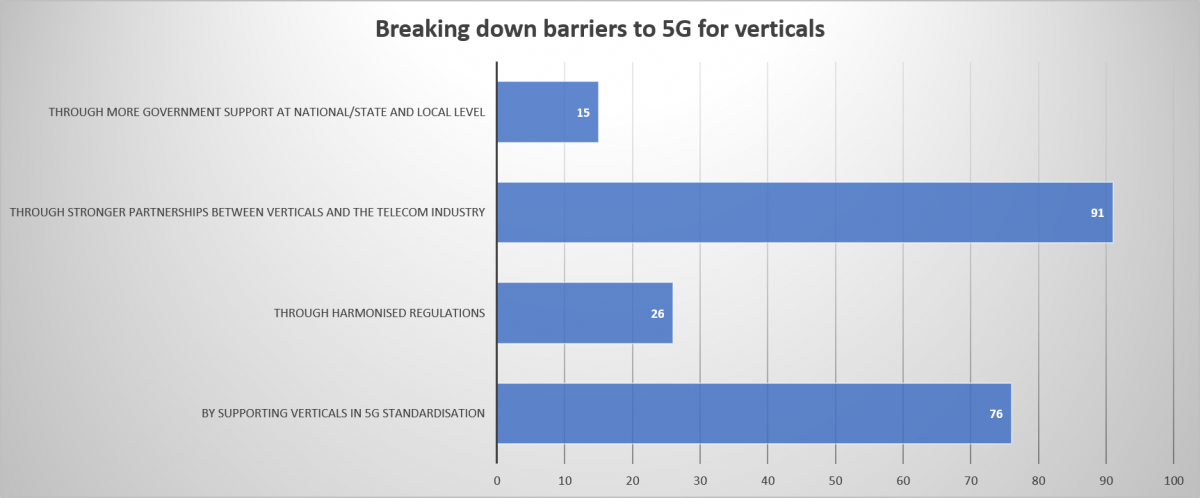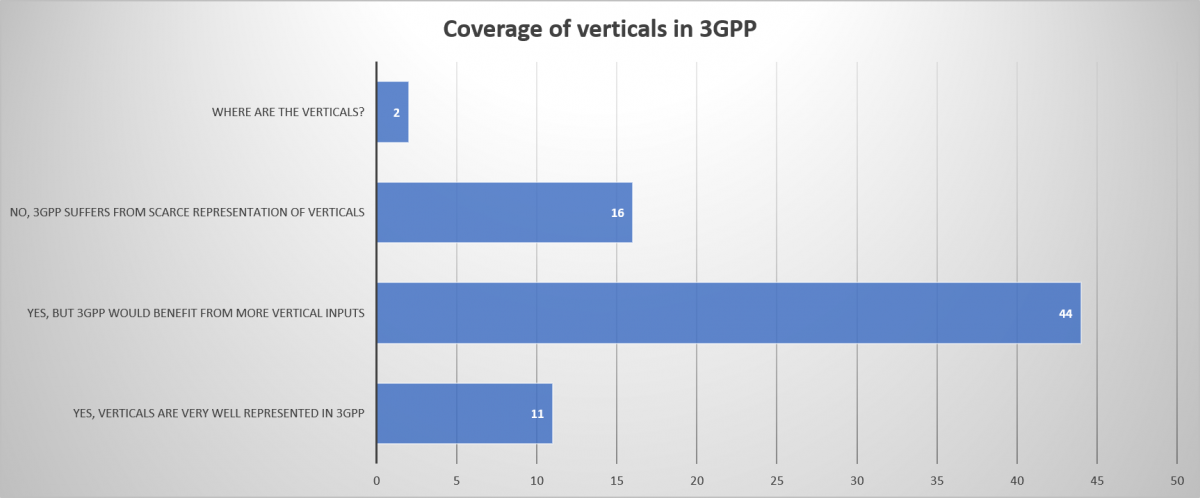Webinar Highlights and Impacts: 3GPP Rel-18 and Industry Verticals
On 30 November 2020, industry vertical associations joined forces with 3GPP Chairmen for RAN and SA to share new requirements that can feed into Release 18 across automotive, broadcasting and media, energy, health and manufacturing. The webinar recording is available on the 5G PPP YouTube Channel here.
Webinar chairs: Stephanie Parker, Vice Chairperson of the 5G-IA Pre-Standardization WG; Trust-IT. John Favaro, Trust-IT and Member of 5G PPP Automotive WG
Georg Mayer, TSG SA Chairman, gave updates on Rel-17, where work across all SA and CT is well under way, and progress towards Rel-18.
- SA2 (Architecture) has completed all its Rel-17 study items and is now poised to start normative work.
- SA1 (Requirements) studies for Rel-18 are progressing towards completion with proposals to "close the door", such as approving the items and taking them to the next level.
- Rel-18 timeline has not yet been defined but it is important to note that all 3GPP timelines are inter-dependent.
- Rel-16, 17 and 18 have a broad variety of vertical features.
- Success of verticals in 3GPP shows that processes work well.
- Many SA1 study items are either vertical services or have a strong impact on verticals (shaded in blue on the slide deck tables):
- Railway smart station services off-network for rail vehicle-mounted relays.
- FRMCS evolution.
- Guidelines for extra-territorial 5G systems.
- Personal IoT networks.
- 5G Timing Resiliency System.
- Sharing administrative configuration between interconnected MCX service systems.
- 5G smart energy and infrastructure.
- 5G networks providing access to localised services.
- Subscriber-aware northbound API access.
- Interconnection and and migration aspects for railways.
- Gateway UE function for mission critical communication.
Georg Mayer slide deck: Release 18 in 3GPP SA (Service and System Aspects).
Members of the 5G Automotive Association (5GAA), Maxime Flament (CTO), Markus Mueck (Intel; Vice-Chairman ETSI Board; 3GPP and 5GAA member) and Antonio Consoli (Huawei and 5GAA) shared requirements for the autmotive sector, highlighting the following new requirements aimed at enhancing existing Predictive QoS mechanism so the network can:
- Send information about QoS prediction directly to the UE through standard interfaces.
- Enable co-existence of reactions to QoS predictions in parallel in the network and in the application.
- Predict future QoS demands (e.g. per location) to manage resources efficiently.
- Enable a vehicle running a V2X application to pre-check alternative routes depending on the requested QoS.
- Support the collection of sidelink QoS measurement data to the network, for more accurate QoS prediction on the sidelink.
5GAA slide deck: 5GAA Inputs to Industry Verticals - 3GPP Release 18 Webinar
Jordi Gimenez, Head of Technology at the 5G Media Action Group (5G-MAG) zoomed on new requirements geared towards further enhancing NPNs (non public networks) and QoS delivery for multicast service:
- Satellite: Integrated access backhaul; enhancements on multicast/broadcast support; continuation of work on NR-NTN, including additional architectural options for NTN (non terrestrial networks) compared with Rel-17.
- Terrestrial: Continuation of work in NR Multicast/Broadcast with other potential topics still under discussion.
- Edge computing: Distributed computing; traffic awareness; adaptation to device capabilities; NWDAF, ML/AI. NWDAF stands for Network Data Analytics Function. In 3GPP, network and user monitoring, traditionally handled by proprietary monitoring tools, becomes native to 5G.
Jordi Gimenez slide deck: 3GPP Release 18 - Next Steps for Media and 5G
Julian Stafford from the European Utilities Telecom Council (EUTC), a new member of 3GPP, and Erik Guttman, Samsung and 3GPP gave insights into new standardisation work for smart energy infrastructure in SA1 with four types of inputs so far, spanning energy services and their requirements, resiliency, operations and management of communications for energy operations; support of essential functions for energy services with the consolidation of other potential requirements still pending. They underscored the following requirements:
- High availability e.g. 99.999% for Feeder Automation and other distribution automation use cases, 99.999-99.9999% for Power Line differential protection.
- Low latency e.g. differential protection in distribution 5ms with accuracy of latency <1ms and <2ms asymmetry.
- Management incident, performance, configuration change and problem reporting interfaces. These include RAN parameters (as available from the UE).
- Regulatory (logical and physical isolation requirements).
- Network services: QoS policy aspects and monitoring for 5GLAN (VLAN) service.
- Density: 10,000 per square km (e.g. advanced metering).
- More requirements with greater specifity will emerge as the study progresses.
Jordi Gimenez slide deck: 3GPP Release 18 - Next Steps for Media and 5G
Julian Stafford slide deck: EUTC - 5G Vertical User Webinar on Release 18. Erik Guttman slide deck: 3GPP Release 18 in SA1,Smart Energy Infrastructure.
Prof. Dr Med Christoph Thuemmler from the Helios Park Klinikum in Leipzig and member of the 5G Health Association focused on the importance of driving 5G-enabled innovations in healthcare to improve patient outcomes through the Saxony-state funded project, 5G-eHealthsax. Prof. Dr Med Gerhard Hindricks, Leipzig Heart Institute, and Markus Dillinger, Huawei, also gave inputs to the presentation. Over 24 months starting in January 2020, the project aims to:
- Build a Test-Bed for XG Health-Technology in Leipzig.
- Implement an Indoor and Outdoor XG Campus Network using 3,7/3,8 GHz.
- Validate the Test-Bed with relevant Use Cases.
- Expand the Testbed, unfold economic activity, offer impartial information to the public and help to enhance and facilitate economic activities.
- Assess standardisation on healthcare and medical applications in 3GPP and elsewhere to pinpoint gaps, define new requirements and drive new inputs.
Christoph Thuemmler slide deck: Helios Digital Health Campus Leipzig
Michael Bahr, Siemens, the 5G Alliance for Connected Industry and Automation (5G-ACIA) and 3GPP Rapporteur highlighted the many industrial requirements that have already been fed into in Rels-16/-17 in SA1 (CAV studies and work items). There is therefore no need for a significant and extensive in terms of Rel-18 studies and technical reports in SA1. However, traceability/tracking of vertical requirements in stage 2/3 work is needed. He underscored the following:
- Promote industrial requirements in Rel-18 not selected for Rel-17 prioritisation:
- Fully decentralised TSN configuration model.
- Generalised concept for ProSe/sidelink usable across diverse industry verticals.
- Specific further requirements based on first deployments and 5G hardware testing.
- New industrial 5G use cases lead to further specific requirements, e.g. machine vision use case with a focus on uplink video communication, e.g. for quality control.
- Specific requirements based on on-going work in 5G-ACIA, e.g. 5G network exposure interface; industrial 5G device; contributions to evaluation models.
- Small, specific requirements specifications.
Michael Bahr slide deck: 3GPP Release 19 - Opportunities for Industry Verticals
The webinar attracted 440 professionals from verticals and the telecom industry, from 22 countries and Europe and 22 countries worldwide, including USA, India and Japan. Participants took part in the live polls on the following:
#1: Breaking down barriers to 5G for verticals. Poll results show that the most effective strategy would be to create stronger partnerships between verticals and the telecom industry, something which the webinar hosts have always strongly encouraged.

#2: Coverage of verticals in 3GPP. Poll results show that 3GPP would benefit from more inputs from industry verticals, which is what the hosts set out to achieve.

